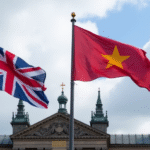Background and Context
Donald Trump, the President of the United States, signed a decree on Thursday to reduce tariffs on Japanese cars, as part of implementing a trade agreement negotiated with Tokyo. This move comes after Japan’s representative traveled to Washington on Thursday to urge Trump to sign the document outlining the previously announced changes.
In late July, both countries had presented an initial trade agreement, but they appeared to differ in their details. Earlier in August, Trump had imposed higher tariffs on Japan, as well as on numerous other economies, adding a 15% rate to existing levels for many products.
Key Changes in Tariffs
Under the new decree, Japanese cars will have a 15% tariff instead of the current 27.5%. Additionally, tariffs on many other products will also be capped at 15%, according to the text of the executive order published by the White House.
Japan’s Pressure and Expected Revisions
Following the imposition of higher tariffs by Trump, Japan’s trade envoy Ryosei Akazawa expressed to journalists his hope that Washington would review the regulation. The changes are required to be implemented within seven days of the norm’s publication in the Federal Register.
Impact and Relevance
This decree is significant as it marks a victory for Japan, which had been actively lobbying the US to lower tariffs on their automobile exports. The reduction in tariffs is expected to ease trade tensions between the two nations and potentially boost Japanese car exports to the United States.
Donald Trump, known for his “America First” policy, has been using tariffs as a tool to negotiate better trade deals for the US. His approach has affected numerous countries, including key allies like Japan, Canada, and the European Union. The recent adjustments to tariffs on Japanese cars reflect an attempt to balance trade relations while addressing concerns of American industries.
Key Questions and Answers
- What is the main purpose of Trump’s decree? The primary objective of the decree is to lower tariffs on Japanese cars from 27.5% to 15%, as part of a trade agreement with Japan.
- Why did Japan push for tariff reductions? Japan sought tariff reductions to alleviate trade tensions with the US and increase their car exports to the American market.
- What were the initial disagreements between the US and Japan? Although both countries had presented a trade agreement in late July, they differed in the details of their proposed accord.
- How will these tariff changes be implemented? The changes must be carried out within seven days of the norm’s publication in the Federal Register.






